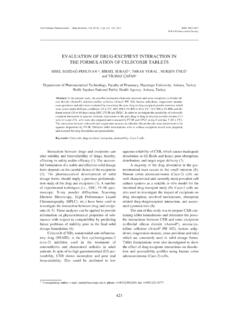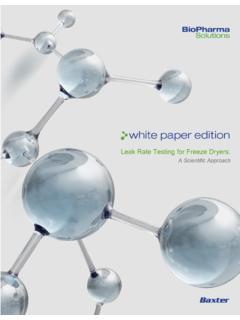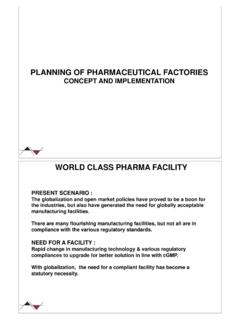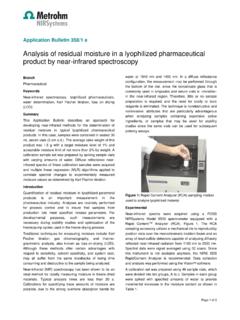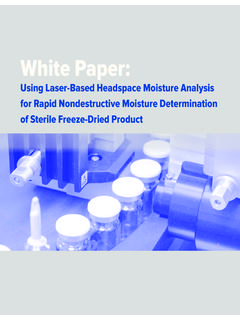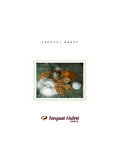Transcription of ORGANIC SOLVENTS IN THE PHARMACEUTICAL …
1 Acta Poloniae Pharmaceutica Drug Research, Vol. 67 No. 1 pp. 3 12, 2010 ISSN 0001-6837. Polish PHARMACEUTICAL Society REVIEW. ORGANIC SOLVENTS IN THE PHARMACEUTICAL INDUSTRY. KATARZYNA GRODOWSKA1,2* and ANDRZEJ PARCZEWSKI1. 1. Jagiellonian University, Faculty of Chemistry, Department of Analytical Chemistry, Ingardena 3, 30-060 Krak w, Poland 2. Pliva Krak w , Mogilska 80, 31-546 Krak w, Poland Abstract: ORGANIC SOLVENTS are commonly used in the PHARMACEUTICAL industry as reaction media, in separation and purification of synthesis products and also for cleaning of equipment. This paper presents some aspects of ORGANIC SOLVENTS utilization in an active PHARMACEUTICAL ingredient and a drug product manufacturing process. As residual SOLVENTS are not desirable substances in a final product, different methods for their removal may be used, provided they fulfill safety criteria.
2 After the drying process, analyses need to be performed to check if amounts of SOLVENTS used at any step of the production do not exceed acceptable limits (taken from ICH. Guideline or from pharmacopoeias). Also new SOLVENTS like supercritical fluids or ionic liquids are developed to replace traditional ORGANIC SOLVENTS in the PHARMACEUTICAL production processes. Keywords: ORGANIC SOLVENTS , residual SOLVENTS , acceptable limits ORGANIC SOLVENTS are constantly present in the In this article, many aspects of ORGANIC SOLVENTS PHARMACEUTICAL production processes. The pharma- use in drug product development and manufacturing ceutical industry is one of the largest users of organ- are presented (acceptable limits and regulations, ic SOLVENTS per amount of the final product (1).)
3 They synthesis, formulation, production, packaging, sol- are usually used at any step of the synthesis pathway vents removal, analytical methods) and new ideas of of an active substance or excipients, and sometimes their replacement with the technologies used in during the drug product formulation process. other industries will be mentioned. Because of some physical and chemical barriers, ORGANIC SOLVENTS cannot be completely eliminated Regulations/legislations from the product by manufacturing practices, such Generally, for objective reasons, the pharma- as drying in an elevated temperature under ceutical industry is a tightly regulated branch of decreased pressure or by lyophilization (freeze-dry- manufacturing. That is the reason why, based on the ing).
4 Usually some small amounts of SOLVENTS may toxicity of individual SOLVENTS , RS limits for phar- remain in the final product. They are called residual maceutical products and excipients have been set by SOLVENTS (RS), also commonly known as ORGANIC different associations. volatile impurities (OVI). Additionally, a drug prod- In the past, the PHARMACEUTICAL industry needed uct may also become contaminated by ORGANIC sol- to unify regulations and limits for residual SOLVENTS . vents from packaging, warehouse storage, or from For many years the United States Pharmacopoeia shipping and transportation. was the only pharmacopoeia setting limits for resid- For toxicological reasons manufacturers aspire ual SOLVENTS in PHARMACEUTICAL products (chapter to minimize the number and amount of SOLVENTS <467> ORGANIC Volatile Impurities).
5 In 1990, limits applied in a drug production. Apart from the fact for RS were proposed in Pharmeuropa (5) and, more that they have no therapeutical value and may be recently, in the second International Conference on toxic, they may additionally accelerate decomposi- Harmonization of Technical Requirements for tion of the product. Special directions published in Registration of Pharmaceuticals for Human Use pharmacopeias and ICH guidelines determine maxi- (ICH) guideline draft. In December 1997 the ICH. mum allowable amounts of RS in PHARMACEUTICAL published its Guidance for Industry Q3C which products (2-4). If amounts of RS are below the lim- became effective in March 1998. ICH guideline its the analyzed product is cleared for sale. compromised regulatory authorities from Europe, * Corresponding author: 3.
6 4 KATARZYNA GRODOWSKA and ANDRZEJ PARCZEWSKI. Japan and the United States, as well as representa- pharmaceuticals in this group. They are less toxic in tives of the research based PHARMACEUTICAL industry. acute or short-term studies, and negative in geno- According to Q3C guideline SOLVENTS are divid- toxicity studies. ed into four groups (2). The first group (Class 1) There is also another group Class 4 SOLVENTS . contains known human carcinogens, compounds For this group there is no adequate toxicological strongly suspected of being human carcinogens, and data enabling formulation of acceptable limits. If environmental hazards Table 1. These SOLVENTS manufacturers want to use Class 4 SOLVENTS , they should be avoided, unless strongly justified.
7 The should supply justification for residual levels of this limits for Class 1 SOLVENTS are listed as absolute parts class SOLVENTS in a PHARMACEUTICAL product (2). per million in a material under testing (drug or As with other guidelines, Q3C only addresses excipient). Class 2 SOLVENTS presented in Table 2 marketed products and not materials used in clinical ought to be limited because they are non-genotoxic trials. animal carcinogens or possible causative agents of ORGANIC SOLVENTS which are most commonly irreversible toxicity, such as neurotoxicity or terato- used in the chemical industry are presented in Table 3. genicity. They are also suspected of other signifi- cant, reversible toxicities. Class 2 SOLVENTS limits Other reasons for control of residual SOLVENTS are listed in two ways (2).
8 Option 1 uses the absolute Toxicity is the main and unquestionable reason parts per million of SOLVENTS contained in the mate- for control of residual solvent amounts, but some- rial being tested and is used in cases where the daily times the presence of RS at levels well within dose is known or fixed and is expressed by the for- acceptable limits, could entail the risk of inducing mula: phase transformations and jeopardizing the physico- Concentration (ppm) = (1000 PDE)/dose (in grams per day) (2) chemical stability of an active substance, and final- where: PDE permissible daily exposure limit in ly the quality of the dosage form. A few reports on milligrams. residual SOLVENTS effects have appeared in literature, In Option 2, the sum of amounts of residual the effect of methylene chloride on the crys- SOLVENTS present in each component of the drug tallinity of ampicillin trihydrate C16H19N3O4S 3H2O).
9 Product per day, should be less than given by PDE. (8) and of residual ethanol on the phase transforma- The ICH Q3C guideline has illustrative tables show- tion of orthorhombic paracetamol (C8H9NO2) (9). ing a passing and failing Option 2 scenario. If a sam- Additional arguments for removing ORGANIC SOLVENTS ple fails Option 1, but passes Option 2 criteria, then from the drug product are the odor or the taste they it passes the residual SOLVENTS requirement. If a sam- can cause, which are obviously not good drug attrib- ple fails both Option 1 and Option 2 criteria then it utes, both for manufacturers and for patients. fails the residual SOLVENTS requirement. Class 3 SOLVENTS have permissions of daily Sources of residual SOLVENTS in a drug product exposures of 50 mg ( ) or less (corresponding to In a task of effectively removing or decreasing 5000 ppm or under Option 1 described for the amount of ORGANIC SOLVENTS present in a drug prod- Class 2) per day.
10 Higher amounts may also be uct it is necessary to investigate ways the drug is con- acceptable when the manufacturer proves that the taminated by the SOLVENTS . Therefore, a short descrip- amounts of Class 3 solvent is realistic with relation tion of the main technological processes where organ- to manufacturing capability and good manufactur- ic SOLVENTS are involved is presented below. ing practice. There is no solvent recognized as a Before a PHARMACEUTICAL company obtains the human health hazard at levels normally accepted in final product tablets, capsules or other pharmaceu- Table 1. Class 1 SOLVENTS (2). Concentration Solvent Concern limit (ppm). Benzene 2 Carcinogen Carbon tetrachloride 4 Toxic and environmental hazard 1,2-Dichloroethane 5 Toxic 1,1-Dichloroethene 8 Toxic 1,1,1-Trichloroethane 1500 Environmental hazard ORGANIC SOLVENTS in the PHARMACEUTICAL industry 5.







